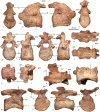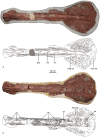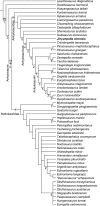The most basal ankylosaurine dinosaur from the Albian-Cenomanian of China, with implications for the evolution of the tail club - PubMed (original) (raw)
The most basal ankylosaurine dinosaur from the Albian-Cenomanian of China, with implications for the evolution of the tail club
Wenjie Zheng et al. Sci Rep. 2018.
Abstract
The tail club knob is a highly specialized structure thought to characterize a subgroup of the ankylosaurine ankylosaurians, and the oldest documented tail club knob in the fossil record occurred in the Campanian ankylosaurine Pinacosaurus. Here we report a new ankylosaurid Jinyunpelta sinensis, gen. et sp. nov., from the Albian-Cenomanian Liangtoutang Formation, Jinyun County, Zhejiang, China. This is the first definitive and the best preserved ankylosaurid dinosaur ever found in southern China. Jinyunpelta possesses unique cranial features differs from other ankylosaurs including two paranasal apertures level with and posterior to the external naris, a triangular fossa on the anterodorsal edge of the maxilla, an antorbital fossa in the junction between the maxilla, lacrimal and jugal, and an anterior process of the prearticular that lies ventral to the splenial. Our phylogenetic analysis suggests Jinyunpelta as the most basal ankylosaurine dinosaur. Jinyunpelta has a tail club with interlocking caudal vertebrae and a well-developed tail club knob, it represents the oldest and the most basal ankylosaurian known to have a well-developed tail club knob. The new discovery thus demonstrates that a large and highly modified tail club evolved at the base of the ankylosaurine ankylosaurs at least about 100 million years ago.
Conflict of interest statement
The authors declare no competing interests.
Figures
Figure 1
Locality and geological maps pertaining to the fossil locality. (a) The map of China showing Zhejiang Province. (b) The map of Zhejiang showing the Jinyun county; (c) map of Jinyun County with the fossil locality (marked by a star); (d) Geological map of Huzhen and Shuhong basins in Jinyun County showing type locality of Jinyunpelta sinensis (marked by a star), (a,b) and (c) Jin, et al., (d) after Lawver, et al..
Figure 2
The skull and mandible of Jinyunpelta sinensis holotype ZMNH M8960. Photograph and line drawing of the skull and mandible in dorsal (a), ventral (b), and anterior (c) views. Abbreviations: an, angular; ar, articular; b, paranasal aperture B; bo, basioccipital; c1, paranasal aperture C1; c2, paranasal aperture C2; d, dentary; en, external naris; exo, exoccipital; f, frontal; fen, fenestra; l, lacrimal; mso, middle supraorbital; mx, maxilla; mf, maxillary fossa; na, nasal; o, orbit; oss, ossicle; pd, predentary; pmx, premaxilla; po, postorbital; pra, prearticular; prf, prefrontal; q, quadrate; qj, quadratojugal; qjh, quadratojugal horn; sa, surangular; sno, supranarial ornamentation; spl, splenial; sq, squamosal.
Figure 3
The skull and mandible of Jinyunpelta sinensis holotype ZMNH M8960. Photograph and line drawing of the skull and mandible in left lateral (a), left ventrolateral (b), right lateral (c) and right ventrolateral (d) views, and enlarged view of the right narial portion (e). Abbreviations: an, angular; ar, articular; b, paranasal aperture B; bo, basioccipital; c1, paranasal aperture C1; c2, paranasal aperture C2; d, dentary; en, external naris; exo, exoccipital; f, frontal; fen, fenestra; l, lacrimal; mso, middle supraorbital; mx, maxilla; mf, maxillary fossa; na, nasal; o, orbit; qjh, quadratojugal horn; oss, ossicle; pd, predentary; pmx, premaxilla; po, postorbital; pra, prearticular; prf, prefrontal; q, quadrate; qj, quadratojugal; qjh, quadratojugal horn; sa, surangular; sno, supranarial ornamentation; spl, splenial; sq, squamosal.
Figure 4
The vertebrae of Jinyunpelta sinensis holotype ZMNH M8960. The axis in anterior (a), left lateral (b), right lateral (c), posterior (d), dorsal (e) and ventral (f) views; the postaxial cervical vertebra in anterior (g), left lateral (h), posterior (i), right lateral (j), ventral (k) and dorsal (l) views; the dorsal vertebra in right lateral (m), anterior (n), left lateral (o), posterior (p), dorsal (q) and ventral (r) views. Abbreviations: c, centrum; di, diapophysis, na, neural arch; nc, neural canal; ns, neural spine; od, odontoid process; pa, parapophysis; poz, postzygapophysis; prz, prezygapophysis; tp, transverse process.
Figure 5
The sacral vertebrae and left ilium of Jinyunpelta sinensis holotype ZMNH M8960 in dorsal (a) and ventral (b) views. Abbreviations: ac, acetabulum; il, ilium; po, plate osteoderm; oss, ossicle; r, rib; sv, sacral vertebra.
Figure 6
The tail club Jinyunpelta sinensis paratype ZMNH M8963 in dorsal (a) and ventral (b) views. Abbreviations: ch, chevron; maj os, major osteoderm of the tail club knob; min os, minor osteoderm of the tail club knob; ns, neural spine; os, osteoderm; ot, ossified tendon; prz, prezygapophyses.
Figure 7
Forelimb of Jinyunpelta sinensis holotype ZMNH M8960. The left scapula in medial (a), lateral (b), dorsal (c) and ventral (d) views; The right humerus in anterior (e) and posterior (f) views; the right manus in dorsal view (g). Abbreviations: acr, acromion; bf, bicipital fossa; dpc, deltopectoral crest; gl, glenoid; glf, glenoid fossa; hh, humeral head; it, internal tuberosity; mc, metacarpal; medr, medial ridge; mtlc, enthesis of M. triceps longus caudalis.
Figure 8
Hind limb of Jinyunpelta sinensis. Left ischium of ZMNH M8963 in lateral (a), anterior (b), medial (c) and posterior (d) views; the right ischium of ZMNH M8960 in lateral (e), anterior (f), medial (g) and posterior (h) views; the left femur of ZMNH M8960 in anterior (i), lateral (j), posterior (k) and medial (l) views; the left tibia and fibula of ZMNH M8963 in anterior (m), lateral (n), posterior (o) and medial (p) views. Abbreviations: 4th, fourth trochanter; ac, acetabulum; fl, fibula; g, scar for the M. gastrocnemius; gt, greater trochanter; lc, lateral condyle; mc, medial condyle; pp, pubic peduncle; s, scar; t, tibia.
Figure 9
The derivative strict reduced consensus tree produced by phylogenetic analysis. Aletopelta, Paw Paw scuteling, Sauroplites, and ‘_Zhejiangosaurus_’ were pruned a posteriori to improve resolution. Values above nodes represent bootstrap proportions. Values beneath nodes indicate Bremer support.
Figure 10
Temporal calibration of the simplified derivative strict reduced consensus tree produced by phylogenetic analysis. Taxa in red text have a tail club knob. The geologic numerical ages and coloring follow International Chronostratigraphic Chart 2017/02.
Similar articles
- Dental microwear of a basal ankylosaurine dinosaur, Jinyunpelta and its implication on evolution of chewing mechanism in ankylosaurs.
Kubo T, Zheng W, Kubo MO, Jin X. Kubo T, et al. PLoS One. 2021 Mar 10;16(3):e0247969. doi: 10.1371/journal.pone.0247969. eCollection 2021. PLoS One. 2021. PMID: 33690686 Free PMC article. - Ankylosaurid dinosaur tail clubs evolved through stepwise acquisition of key features.
Arbour VM, Currie PJ. Arbour VM, et al. J Anat. 2015 Oct;227(4):514-23. doi: 10.1111/joa.12363. Epub 2015 Aug 31. J Anat. 2015. PMID: 26332595 Free PMC article. - A new basal hadrosauroid dinosaur from the Late Cretaceous of Uzbekistan and the early radiation of duck-billed dinosaurs.
Sues HD, Averianov A. Sues HD, et al. Proc Biol Sci. 2009 Jul 22;276(1667):2549-55. doi: 10.1098/rspb.2009.0229. Epub 2009 Apr 22. Proc Biol Sci. 2009. PMID: 19386651 Free PMC article. - A Basal Lithostrotian Titanosaur (Dinosauria: Sauropoda) with a Complete Skull: Implications for the Evolution and Paleobiology of Titanosauria.
Martínez RD, Lamanna MC, Novas FE, Ridgely RC, Casal GA, Martínez JE, Vita JR, Witmer LM. Martínez RD, et al. PLoS One. 2016 Apr 26;11(4):e0151661. doi: 10.1371/journal.pone.0151661. eCollection 2016. PLoS One. 2016. PMID: 27115989 Free PMC article. - The origin and early evolution of dinosaurs.
Langer MC, Ezcurra MD, Bittencourt JS, Novas FE. Langer MC, et al. Biol Rev Camb Philos Soc. 2010 Feb;85(1):55-110. doi: 10.1111/j.1469-185X.2009.00094.x. Epub 2009 Nov 6. Biol Rev Camb Philos Soc. 2010. PMID: 19895605 Review.
Cited by
- Dental microwear of a basal ankylosaurine dinosaur, Jinyunpelta and its implication on evolution of chewing mechanism in ankylosaurs.
Kubo T, Zheng W, Kubo MO, Jin X. Kubo T, et al. PLoS One. 2021 Mar 10;16(3):e0247969. doi: 10.1371/journal.pone.0247969. eCollection 2021. PLoS One. 2021. PMID: 33690686 Free PMC article. - The phylogenetic nomenclature of ornithischian dinosaurs.
Madzia D, Arbour VM, Boyd CA, Farke AA, Cruzado-Caballero P, Evans DC. Madzia D, et al. PeerJ. 2021 Dec 9;9:e12362. doi: 10.7717/peerj.12362. eCollection 2021. PeerJ. 2021. PMID: 34966571 Free PMC article.
References
- Bureau of Geology and Mineral Resources of Zhejiang Province. Regional Geology of Zhejiang Province. (Geological Publishing House, 1989).
- Zheng W, Jin X, Shibata M, Azuma Y, Yu F. A new ornithischian dinosaur from the Cretaceous Liangtoutang Formation of Tiantai, Zhejiang Province, China. Cretaceous Research. 2012;34:208–219. doi: 10.1016/j.cretres.2011.11.001. - DOI
- Wang, Y.-Z., Jiang, Y.-G. & Chen, K.-Q. The study of dinosaur fossil and Late Cretaceous basin of Tiantai in Zhejiang. Unpublished file report of the Hydrology and Engineering Geological Brigade of Zhejiang Province and Institute of Mineral Resources Chinese Academy of Geological Sciences (2000).
- He H, et al. SIMS zircon U–Pb dating of the Late Cretaceous dinosaur egg-bearing red deposits in the Tiantai Basin, southeastern China. Journal of Asian Earth Sciences. 2013;62:654–661. doi: 10.1016/j.jseaes.2012.11.015. - DOI
- Jiang Y, Qian M-P, Xing G-F, Jiang Y-G. Zircon U-Pb Age of the dinosaur-bearing strata in the Tiantai Basin of Zhejiang. Journal of Stratigraphy. 2016;40:272–277.
Publication types
MeSH terms
LinkOut - more resources
Full Text Sources
Other Literature Sources









